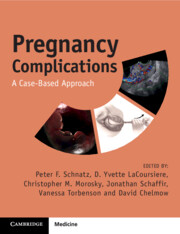Book contents
- Pregnancy Complications
- Pregnancy Complications
- Copyright page
- Contents
- Contributors
- Preface
- Note from the Editor-in-Chief
- Normal Laboratory Values (Conventional Units) []
- Section 1 Antepartum (Early Pregnancy)
- Section 2 Antepartum (Mid-trimester)
- Section 3 Antepartum (Late Pregnancy)
- Case 20 A Patient with Regular Painful Uterine Contractions at 32 Weeks
- Case 21 A 25-Year-Old Presents at 22 Weeks’ Gestation Leaking Clear Fluid
- Case 22 A 40-Year-Old at 34 Weeks’Gestation with Worsening Itching
- Case 23 A 25-Year-Old Presents at 30 Weeks’ Gestation Following a Motor Vehicle Accident
- Case 24 A 20-Year-Old Presents at 34 Weeks’ Gestation with Pruritic Abdominal Rash
- Case 25 A 30-Year-Old Presents at 18 Weeks’ Gestation with Severe Right Back and Flank Pain
- Case 26 A 30-Year-Old at 18 Weeks’ Gestation with Fever, Dysuria, Worsening Flank Pain, and Hydronephrosis
- Case 27 A 35-Year-Old with Abdominal Wall Bulge at 24 Weeks’ Gestation
- Case 28 A 30-Year-Old Presents for a Prenatal Visit at 41 Weeks’ Gestation
- Case 29 A 40-Year-Old Presents at 34 Weeks’ Gestation with Absent Fetal Movement
- Case 30 A 25-Year-Old at 36 Weeks’ Gestation Presents with Severe Bilateral Wrist Pain
- Case 31 A 20-Year-Old Presents at 31 Weeks’ Gestation with Severe Abdominal Pain and Constipation
- Section 4 Antepartum (Medical Complications)
- Section 5 Antepartum (Infectious Complications)
- Section 6 Intrapartum/Delivery
- Section 7 Postpartum
- Section 8 Fetal Complications
- Section 9 Placental Complications
- Section 10 Complications of the Cord, Amnion, and Gravid Uterus
- Section 11 Psychosocial Considerations
- Index
- References
Case 29 - A 40-Year-Old Presents at 34 Weeks’ Gestation with Absent Fetal Movement
from Section 3 - Antepartum (Late Pregnancy)
Published online by Cambridge University Press: 08 April 2025
- Pregnancy Complications
- Pregnancy Complications
- Copyright page
- Contents
- Contributors
- Preface
- Note from the Editor-in-Chief
- Normal Laboratory Values (Conventional Units) []
- Section 1 Antepartum (Early Pregnancy)
- Section 2 Antepartum (Mid-trimester)
- Section 3 Antepartum (Late Pregnancy)
- Case 20 A Patient with Regular Painful Uterine Contractions at 32 Weeks
- Case 21 A 25-Year-Old Presents at 22 Weeks’ Gestation Leaking Clear Fluid
- Case 22 A 40-Year-Old at 34 Weeks’Gestation with Worsening Itching
- Case 23 A 25-Year-Old Presents at 30 Weeks’ Gestation Following a Motor Vehicle Accident
- Case 24 A 20-Year-Old Presents at 34 Weeks’ Gestation with Pruritic Abdominal Rash
- Case 25 A 30-Year-Old Presents at 18 Weeks’ Gestation with Severe Right Back and Flank Pain
- Case 26 A 30-Year-Old at 18 Weeks’ Gestation with Fever, Dysuria, Worsening Flank Pain, and Hydronephrosis
- Case 27 A 35-Year-Old with Abdominal Wall Bulge at 24 Weeks’ Gestation
- Case 28 A 30-Year-Old Presents for a Prenatal Visit at 41 Weeks’ Gestation
- Case 29 A 40-Year-Old Presents at 34 Weeks’ Gestation with Absent Fetal Movement
- Case 30 A 25-Year-Old at 36 Weeks’ Gestation Presents with Severe Bilateral Wrist Pain
- Case 31 A 20-Year-Old Presents at 31 Weeks’ Gestation with Severe Abdominal Pain and Constipation
- Section 4 Antepartum (Medical Complications)
- Section 5 Antepartum (Infectious Complications)
- Section 6 Intrapartum/Delivery
- Section 7 Postpartum
- Section 8 Fetal Complications
- Section 9 Placental Complications
- Section 10 Complications of the Cord, Amnion, and Gravid Uterus
- Section 11 Psychosocial Considerations
- Index
- References
Summary
The rate of IUFD is 5.74 per 1,000 live births and decreases to 2.78 per 1,000 live births after 28 weeks. All of these patients should be offered fetal autopsy, genetic evaluation, and examination of the placenta, umbilical cord, and membranes. Other testing is individualized by case. The SMFM and ACOG have proposed an algorithm to assist clinicians: www.smfm.org/publications/322-acog-smfm-occ-10-management-of-stillbirth. Dilation and evacuation and induction of labor are delivery options prior to 28 weeks and depend on patient preference and history. After 28 weeks, general obstetrical protocols for induction of labor are recommended. Antepartum surveillance is recommended starting at 32 weeks and is individualized in patients with a history of IUFD prior to 32 weeks. Consideration can be made to fetal growth scan. Delivery timing is determined by a discussion of the fetal and maternal risks of delivery at or before 39 weeks
- Type
- Chapter
- Information
- Pregnancy ComplicationsA Case-Based Approach, pp. 89 - 91Publisher: Cambridge University PressPrint publication year: 2025

